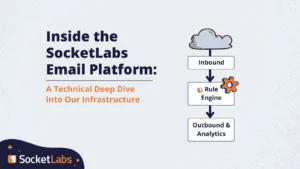
Even for the most direct sending use cases where you’re sending on a single domain, email best practices can feel a little bit more like…suggestions. Sometimes we’re guilty of not using our best judgment and while sometimes there’s little to no consequence, that doesn’t mean they’re not important. Like…REALLY important.
Best practices for every sender
In fact, following email best practices surrounding data quality, authentication, performance and security are all essential to email senders and the email service providers (ESPs) who support their activities.
NOT email best practices
These are pitfalls to avoid no matter what kind of sender you are:
❌ If your mail is not properly authenticated or there are misalignment issues within the email headers, your mail might not get delivered.
This can be somewhat difficult to track as an ESP, but SocketLabs has some new technology allowing you to see which subaccounts are fully, partially, or not at all authenticated to make it easier and faster to discern.
❌ If you’re sending mail to recipients who haven’t opted-in or already opted out, your inbox placement will suffer through high bounces and spam complaints.
ESPs need to be particularly careful about these negative reputation signals because they can seriously impact not only one IP’s reputation, but can also poison an entire IP pool.
❌ If you’re not taking advantage of real-time data to identify issues and optimize performance, you could be making things worse, or missing problematic trends entirely.
For ESPs or complex senders, an issue can quickly spiral out of control and affect not only the one subaccount or domain causing the problem, but others using the same IP or pool.
❌ For our ESP friends in particular, if service goes down and you don’t have a contingency plan in place, you’ll be dealing with unhappy customers and an increase in support costs…also churn.
YAS email best practices
Email senders and ESPs alike, ensure you have the following buttoned up to have the best chance of success:
✅ Nail the basics like requiring permission, handling bounces and suppressions, and ensuring proper authentication.
Create processes to continually verify these foundational issues are never a problem for you. After all, it’s really hard to keep your house intact when the foundation is crumbling. Ugly mess.
✅ Get everyone internally on the same page about your processes, terms of service (TOS) and acceptable use policy (AUP), then enforce those policies.
There should be very little, if any, leeway for senders who cannot get themselves together. A warning could be warranted, but if there isn’t any improvement in their behavior, they gotta go.
Are you a direct sender? Be warned, your ESP can fire you, too.
✅ Ensure your team has proper visibility into email performance and can spot issues before something is on fire. The closer to real-time, the better. The more time you waste waiting for the data to come through, the more time the problem has to multiply, escalate, and spread collateral damage.
✅ If you’re sending email through someone else’s pipes, secure a redundancy provider for business continuity and maintaining customer confidence. While this is mainly for the service providers in the house, direct senders should understand how their ESP operates. Is your ESP powered by a larger entity? It’s not uncommon for smaller ESPs to use a larger provider’s technology to actually send mail. While you send and manage your email program via the ESP you pay, it’s very possible the mail is flying through another ESP’s infrastructure. The more you know!
That’s a wrap
We could talk about email best practices for optimal delivery and a great reputation for both senders and providers for days. But…we won’t put you through that. Unless…you want to, and in that case, let’s connect.







